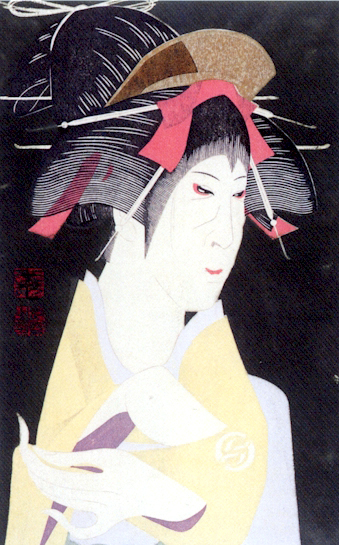| BUNGO DÔJÔJI |
| Play title | Bungo Dôjôji |
| Authors | Imafuji Chôjûrô III, Kiyomoto Shizutayû (music) Fujima Kanjûrô VI (choreography) |
| History |
The Kiyomoto-based dôjôjimono dance-drama "Bungo Dôjôji" was premiered in October 1982 at the Kabukiza [casting]. The music for Bungo Dôjôji was written by Imafuji Chôjûrô III and Kiyomoto Shizutayû, and it was first heard at a music recital in 1980. Such was the admiration it received that soon after this, choreography was commissioned from Fujima Kanjûrô to accompany it, and Bungo Dôjôji was first performed as a Kabuki dance in 1982. The story and lyrics are taken from the older dance, Kyôkanoko Musume Dôjôji. However, the new Kiyomoto music, performed in the style of the old Bungo-bushi School, replaces the original Nagauta composition and transforms the work, giving it a more serious air with greater intensity of emotion. The actor for whom it was choreographed was Nakamura Jakuemon IV. Courtesy of Paul M. Griffith |
| Key words |
Bungo-bushi Dôjôji Dôjôji (Nô) Dôjôjimono Kiyomoto Kudoki Shosagoto Suppon Uroko |
| Summary |
The story tells of the maiden Kiyohime who, having fallen in love with a wandering priest, developed so passionate an attachment to him that she pursued the man all the way to the temple, Dôjôji. Finding that he had hidden himself under the great bell, her bitterness and rage transformed her into a fiery serpent that coiled around the bell, melting both it and the priest beneath. Now, some time later, it is the spirit of that maiden who returns to destroy the new bell. Describing the lovely spring landscape around the temple, the lyrics begin with the famous opening lines: "Apart from the fair blossoms, there is only pine. As dusk falls, the toll of the bell echoes through the hills." The spirit of Kiyohime rises on the suppon stage lift, and slowly makes her way towards the temple. The musicians begin to sing of the times when the bell is struck, tolling out that all worldly things are transient. We should imagine that the maiden soon persuades the foolish acolytes to allow her inside the temple grounds by offering to entertain them with a series of dances. In these she portrays a variety of women, including a bashful city girl whose thoughts centre on romance, an innocent girl at her games, and a proud and haughty courtesan, as the singers describe the different red light districts in old Japan. Shortly after this we reach the major highlight of the work, the kudoki, 'entreaty'. No longer an innocent young maiden, we now see a woman more experienced in the ways of love, and she pours out her heartache to an imaginary partner. At last, this vengeful spirit of Kiyohime sees her chance to destroy the new bell. In a departure from the original dance Musume Dôjôji, the lyrics of this final section are taken directly from the Nô play Dôjôji. We hear: "Now that people are asleep, I see my chance! Continuing to dance, I will approach my target. I would strike the bell for, thinking back, how it fills me with bitter hatred!" The design of silver triangles at her shoulder, called uroko, represents a serpent's scales as the dance Bungo Dôjôji comes to a close. Courtesy of Paul M. Griffith |
 |
|
Nakamura Jakuemon IV playing the role of Kiyohime in the dance-drama "Bungo Dôjôji" in a print made by Tsuruya Kôkei in October 1982 Print courtesy of Ted Jagoda |
|
|
| Contact | Main | Top | Updates | Actors | Plays | Playwrights | Programs | Links | FAQ | Glossary | Chronology | Illustrations | Prints | Characters | Derivatives | Theaters | Coming soon | News |